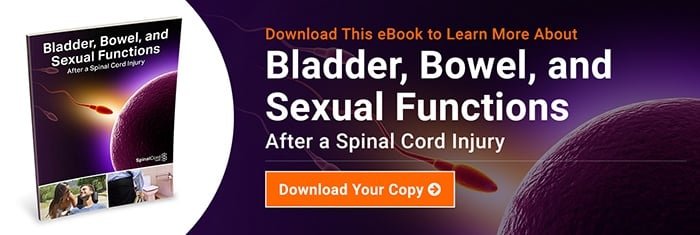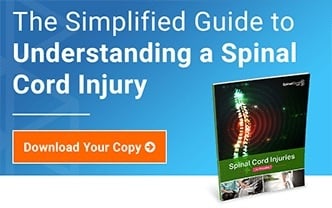3 Significant Spinal Cord Functions to Know
For some people, the spinal cord is a bit of a mystery. Sure, they may know that it is the communication system that allows the brain to communicate with the rest of the body. But, that may be the extent of their knowledge. Others may not realize that the spinal cord structure isn’t actually a single “cord;” rather, it’s a complex bundle of 31 separate spinal nerves that starts at the base of your brain and runs down through the vertebral canal of the spine, which is composed of the 33 bones that run along your back.
While knowing some aspects of the physical anatomy of the spinal cord is helpful, there is more that needs to be understood — particularly when you’ve suffered a traumatic spinal cord injury (SCI) and want to have a greater understanding of your body. What does the spinal cord do? What does each of the spinal nerves do or control? Why do some spinal cord injuries have significantly worse impacts on a person’s independence and mobility than others?
We’re here to answer these questions about spinal cord structure and spinal cord functions along with others you may not realize that you have.
Understanding Spinal Cord Function and Structure
1. The Structure of the Spinal Cord, Nerves, and Matter
The spinal cord is divided into five main sections (listed top-down). Each contains a different number of spinal cord nerves, which are responsible for carrying sensory, motor, and autonomic signals between the brain and body in the form of electrical currents. According to the Rick Hansen Institute, each of the different levels of nerves control different types of functions:
- Cervical (neck) — These eight cervical spinal cord nerves control head and neck movements, hand and wrist muscles, biceps, deltoids, and diaphragm function (which helps to control breathing).
- Thoracic (chest/upper back) — These 12 thoracic spinal cord nerves predominantly control abdominal muscles and trunk stability; they also can affect respiratory function through the intercostal muscles in your ribs.
- Lumbar (abdominal/lower back) — These five spinal cord nerves can affect control of your legs and hips, as well as your bladder, bowel, and sexual functions.
- Sacral (pelvic) — These five spinal cord nerves affect the same areas as the lumbar spinal cord.
- Coccygeal (tailbone) — While this section of the spine includes one spinal cord nerve, “an injury to the coccyx is not associated with any significant loss of nerve function.”
Grey and White Matter
The spinal cord and brain both contain both grey matter and white matter, which are where neurons synapse and transfer information between the body and brain. Grey matter, which is divided into dorsal, lateral, and ventral “horns,” contains neural cell bodies, dendrites, axon terminals, and all nerve synapses. Damage or issues relating to this matter can affect your brain’s sensory and motor functions, and may even result in tingling, muscle weakness, or paralysis.
White matter, which surrounds and connects the grey matter, consists of axon bundles that are coated with a mixture of lipids and proteins (myelin) that conducts nerve signals and protects the axons. Damage to this matter can affect your sensory and reaction capabilities to external stimuli as well as your motor functions.
2. The Spinal Cord Serves as Part of the Central Nervous System
Together, your spinal cord and brain form your body’s central nervous system (CNS), which is part of the overarching nervous system. The nervous system also consists of the peripheral nervous system (PNS), which is comprised of the autonomic nervous system and the somatic nervous system. Autonomic functions are those that we don’t control and are involuntary; somatic functions are the voluntary movements that we can control.
This incredibly complex nervous system serves as your body’s relay station, in which case the spinal cord functions by transmitting information between your body and brain every nanosecond. It plays a critical role in our most basic functions — and, without this system, we wouldn’t be alive.
That’s why when a spinal cord injury occurs — even if the rest of your body is healthy and functioning — it can undermine the most basic functions and abilities that you’re accustomed to.
3. The Spinal Cord Aids in Regulating Various Bodily Systems
The spinal cord sends and receives signals from the brain and body about your surrounding environment, essentially serving as your body’s processing center. Before your spinal cord injury, this is the function that would allow your body to register that you were uncomfortable in a specific position and needed to move. The spinal cord would then communicate that information to your brain, which then responded with orders to various parts of your body to shift positions.
Another example is when your body sensed that you were cold. Your spinal cord communicated signals about your body’s state to the brain, which reacted with signals that initiate changes, so you’d shiver, grab a blanket, or adjust the thermostat.
When you became injured, your injury interrupted these very intricate signal communications. A spinal cord injury can alter the physical structure of the spinal cord, potentially severing the nerves as a result of having an internal or foreign object pressing against it. As a result, it may be challenging for your body to self-regulate or respond to external stimuli.
When all of these different systems are fully functional, you are able to walk, talk, move, and respond to internal and external stimuli. When an external factor, such as a spinal cord injury that occurs from a car accident or fall, damages the spinal cord, it throws a proverbial wrench into the “well-oiled machine” that is your body. Sensory, motor, and reflex functions are affected or impeded when the brain can’t transmit impulses past the injury site in the spinal cord.
The higher up the damage on the spinal cord, the more significant the damage and loss of function. However, there are options for spinal cord injury treatments that show promise for the future as technologies continue to evolve and become more advanced.
We hope that this information on spinal cord function and spinal cord structure is helpful to you. To learn about more functions after a spinal cord injury as far as bladder, bowel and sexual issues are concerned, be sure to check out our free resource by clicking on the link below.
Stay Updated on Advancements On Traumatic Brain &
Spinal Cord Injuries
About the Author





